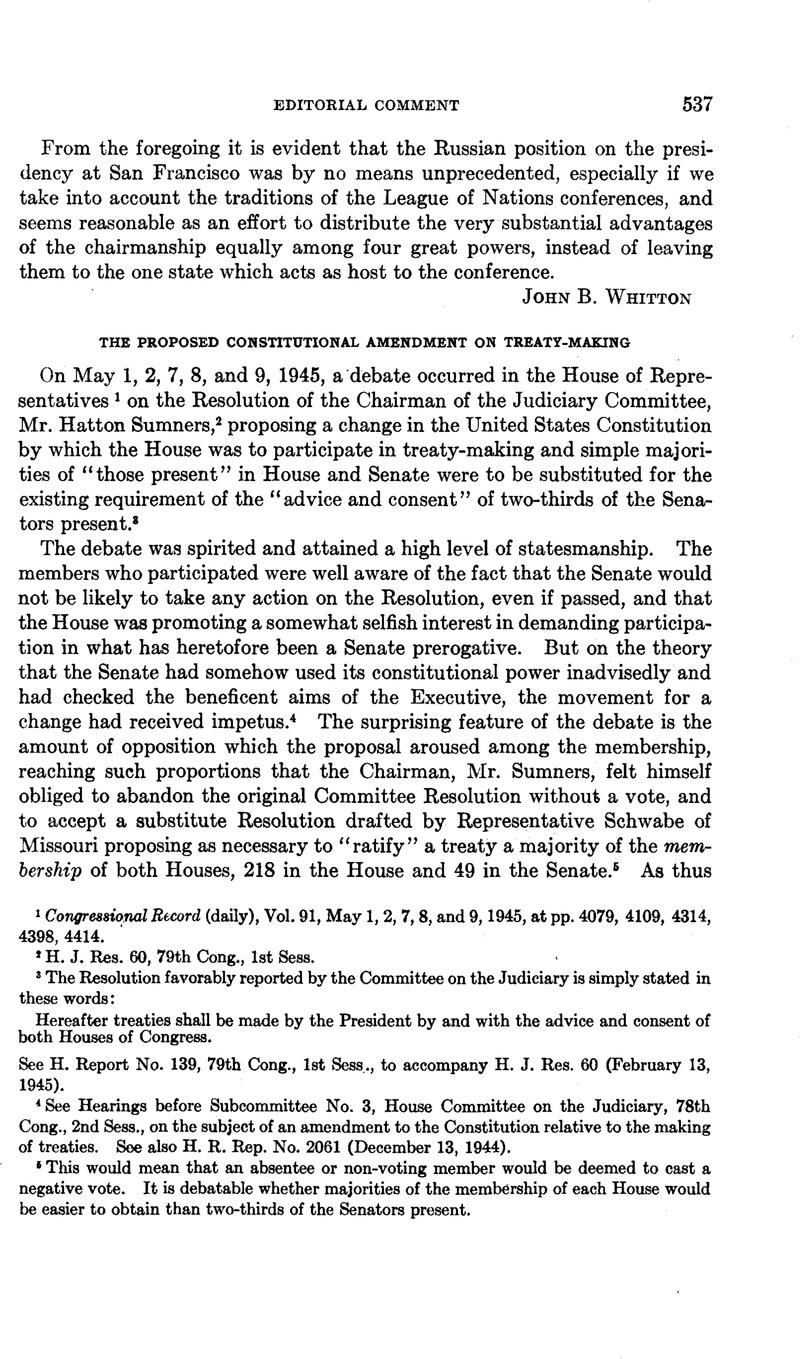Published online by Cambridge University Press: 25 April 2017

1 Congressional Record (daily), Vol. 91, May 1,2,7,8, and 9,1945, at pp. 4079, 4109, 4314, 4398,4414.
2 H. J. Res. 60, 79th Cong., 1st Sess.
3 The Resolution favorably reported by the Committee on the Judiciary is simply stated in these words: Hereafter treaties shall be made by the President by and with the advice and consent of both Houses of Congress. See H. Report No. 139, 79th Cong., 1st Sess., to accompany H. J. Res. 60 (February 13, 1945).
4 See Hearings before Subcommittee No. 3, House Committee on the Judiciary, 78th Cong., 2nd Sess., on the subject of an amendment to the Constitution relative to the making of treaties. See also H. R. Rep. No. 2061 (December 13, 1944).
5 This would mean that an absentee or non-voting member would be deemed to cast a negative vote. It is debatable whether majorities of the membership of each House would be easier to obtain than two-thirds of the Senators present.
6 Congressional Record (daily), Vol. 91, May 9, 1945, at pp. 4440-41.
7 Mr. Gossett of Texas in same, May 1, 1945, at 4082.
8 Mr. Kefauver of Tennessee in same, May 2, 1945, at 4111; Mr. Wadsworth of New York in same, at 4134.
9 Mr. Baldwin of New York in same, at 4129; Mr. Robsion of Kentucky, same, May 9, 1945, at 4420. Said Mr. Celler of New York, another proponent of the amendment: “But such procedure [executive agreement] is not wise nor is it healthy.” Same, May 2, 1945, at p. 4117.
10 See editorial in this JOURNAL, Vol. 38, p. 639, note 9.
11 Kenneth Colegrove, The American Senate and World Peace, New York, 1944, p. 31:
An executive agreement as a substitute for a treaty comes dangerously close to an evasion of the Constitution. The employment of this method would place the post-war pacts on a basis that lacks the traditional validity of treaty-law. It would leave an uncertainty in the minds of our allies who would find American commitments resting on an arrangement which is not expressly denned in the Constitution.
Mr. Colegrove concludes p. 110:
The use of executive agreements as a substitute for a peace settlement is a palpable evasion of the fundamental law. The Constitution is clear and unambiguous on the subject of treaties.
12 Wallace McClure, International Executive Agreements, New York, 1941.
13 315 U.S. 203(1942).
14 See the subjects commonly cast in treaty form listed in the speech of Mr. Merrow of New Hampshire, Congressional Record (daily), Vol. 91, May 7, 1945, at p. 4320.
15 Congressional Record, (daily), Vol 1, May 1, 1945, at p. 4099.
16 James A. Farley, Behind the Ballots, New York, 1938, pp. 361, 362.
17 Mr. Robsion, for example, said that the resolution “adds greatly to the power of the President and proportionately weakens the power of Congress“: Congressional Record (daily), Vol. 91, May 1, 1945, at 4119.
18 See, in debate, Mr. Baldwin (Congressional Record, May 2, 1945, at p. 4129), Mr. Springer (May 8,1945, at p. 4399); Mr. Ludlow (May 1, 1945, at p. 4099); and Mr. Robsion (May 1, 1945, at 4119).
19 Representative Springer's Resolution to this effect was defeated by 103 votes to 61 (Congressional Record, May 9, 1945, at p. 4415).
20 These two arguments seemed to impress the New York State Bar Association, which on February 17, 1945, voted “overwhelmingly” against the proposed Judiciary Committee Amendment, endorsed by the Association's own Committee on International Law, 11 votes to 2. The New York Times, February 18, 1945.
21 Sustained in Missouri v. Holland, 252 U. S. 416 (1920).
22 This was originally to be an executive agreement. As such, it was signed August 8, 1944. Chairman Connally protested, after an opinion and a study of the subject by Mr. Henry S. Fraser to the effect that since it committed the United States to future legislative obligations, the agreement must take the form of a treaty. See Sen. Doc. No. 244, 78th Cong., 2nd Sess. (1944). On August 24, 1944, it was submitted to the Senate as a treaty. Senator Connally, after reading it, expressed the opinion that it would not receive a twothirds vote. President Roosevelt on January 10, 1945, withdrew the treaty for renegotiation with Great Britain. When the industry heard about the Agreement they protested its substance, which proposed to centralize the administration of production and distribution of petroleum in the Federal Government. Both the Committee and the industry, after a hearing, proposed a redraft.
23 The fact that the cases of United States v. Belmont, 301 U. S. 324 (1937), and United States v. Pink, 315 U. S. 203 (1942), sustained the power of the President to change property relations is one of the most convincing reasons why the Litvinoff Assignment may not have been correctly construed and why its extension is fraught with danger. See editorial, this JOURNAL, Vol. 38, p. 637.
24 Congressional Record (daily), Vol. 91, May 2, 1945, at p. 4118. Page no 154 1 This reference is to the Dumbarton Oaks Proposals. The corresponding provision of the San Francisco Charter is Art. 35.